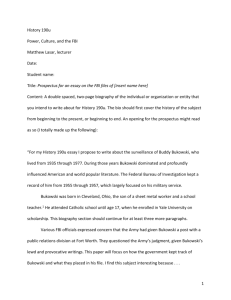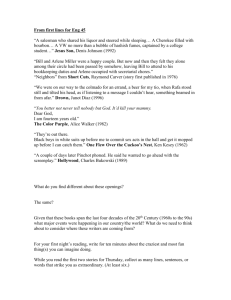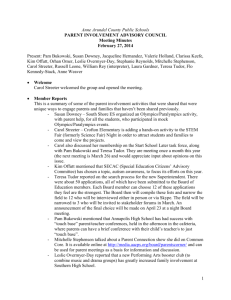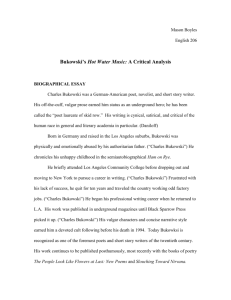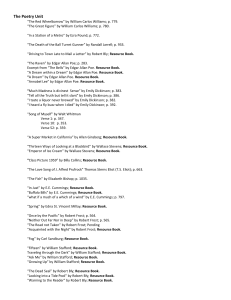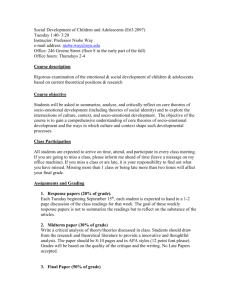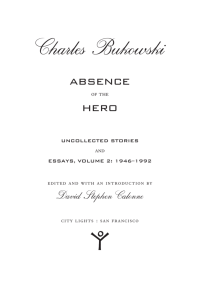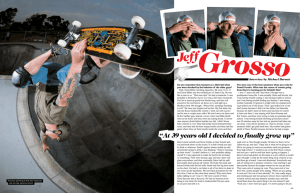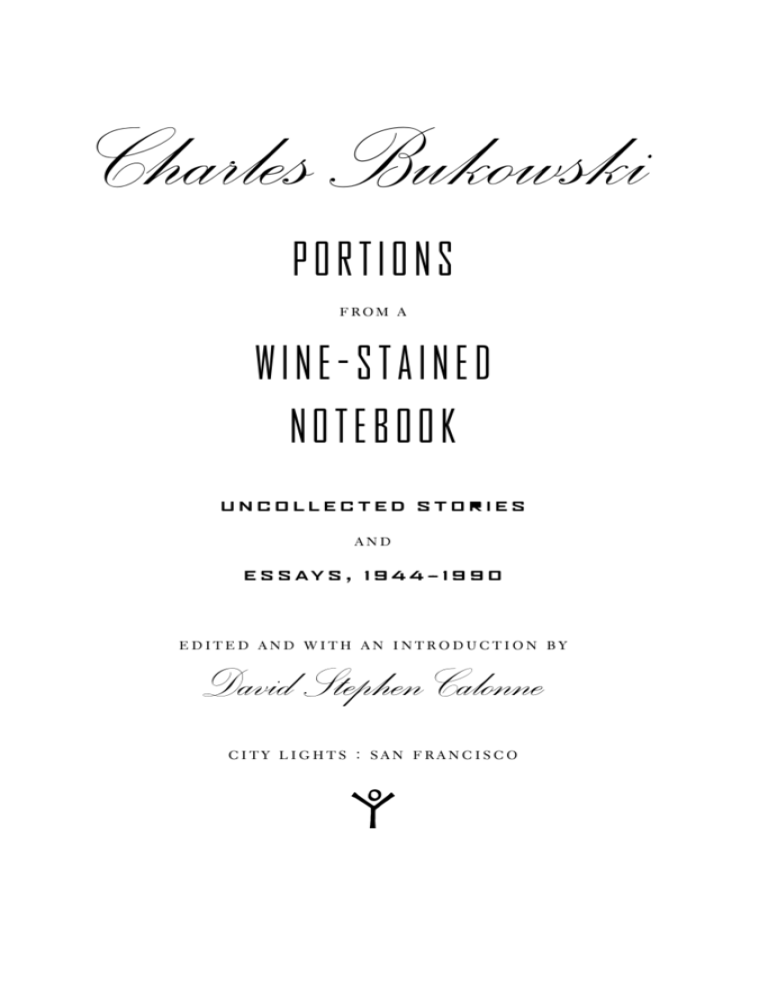
CharlesBukowski
PORTIONS
from a
WINE-STAINED
NOTEBOOK
UNCOLLECTED STORIES
and
E S S A Y S , 1 9 4 4 -- 1 9 9 0
edited and with an introduction by
David Stephen Calonne
city lights : san francisco
Copyright © 2008 by The Estate of Charles Bukowski
Introduction copyright © 2008 by David Stephen Calonne
All rights reserved
Library of Congress Cataloging-in-Publication Data
Bukowski, Charles.
Charles Bukowski : portions from a wine-stained notebook :
uncollected stories and essays, 1944–1990 /
edited and with an introduction by David Stephen Calonne.
p. cm.
Includes bibliographical references.
isbn 978-0 -87286-496-2 (hardback)
isbn 978-0 -87286-492-4 (paperback)
I. Calonne, David Stephen, 1953– II. Title.
ps3552.u4a6 2008
811´.54—dc22
2008020485
Design and composition by Quemadura
Cover photograph by Linda Lee Bukowski
Visit our website: www.citylights.com
City Lights Books are published
at the City Lights Bookstore
261 Columbus Avenue
San Francisco, CA 94133
CONTENTS
acknowledgments
[ ix ]
introduction
[ xi ]
A F T E R M AT H O F A L E N G T H Y R E J E C T I O N S L I P
[1]
2 0 TA N K S F R O M K A S S E L D O W N
[11]
HARD WITHOUT MUSIC
[15]
Trace :
EDITORS WRITE
[19]
P O R T I O N S F R O M A W I N E - S TA I N E D N O T E B O O K
[20]
A R A M B L I N G E S S AY O N P O E T I C S A N D T H E B L E E D I N G L I F E
W R I T T E N W H I L E D R I N K I N G A S I X- P A C K ( T A L L )
[33]
I N D E F E N S E O F A C E R TA I N T Y P E O F P O E T R Y
TYPE OF LIFE
,
,
A C E R TA I N
A C E R TA I N T Y P E O F B L O O D - F I L L E D
C R E A T U R E W H O W I L L S O M E D AY D I E
[41]
A R TA U D A N T H O L O G Y
[49]
AN OLD DRUNK WHO RAN OUT OF LUCK
[54]
NOTES OF A DIRTY OLD MAN
[57]
U N T I T L E D E S S AY I N
A Tribute to Jim Lowell
[61]
NOTES OF A DIRTY OLD MAN
[63]
T H E N I G H T N O B O D Y B E L I E V E D I WA S A L L E N G I N S B E R G
[70]
’
SHOULD WE BURN UNCLE SAM S ASS?
[78]
T H E S I LV E R C H R I S T O F S A N TA F E
[82]
DIRTY OLD MAN CONFESSES
[87]
READING AND BREEDING FOR KENNETH
[105]
. .
THE L A
SCENE
[111]
NOTES ON THE LIFE OF AN AGED POET
[121]
U P O N T H E M A T H E M A T I C S O F T H E B R E A T H A N D T H E WAY
[128]
NOTES OF A DIRTY OLD MAN
[135]
NOTES OF A DIRTY OLD MAN
[141]
NOTES OF A DIRTY OLD MAN
[148]
UNPUBLISHED FOREWORD TO
’
W I L L I A M WA N T L I N G S
7 on Style
[151]
JAGGERNAUT
[156]
PICKING THE HORSES
[162]
WORKOUT
[169]
T H E WAY I T H A P P E N E D
[181]
J U S T PA S S I N G T I M E
[188]
DISTRACTIONS IN THE LITERARY LIFE
[197]
I MEET THE MASTER
[205]
CHARLES BUKOWSKI S LOS ANGELES FOR LI PO
’
[230]
L O O K I N G B A C K AT A B I G O N E
[231]
ANOTHER
Portfolio
[234]
THE OTHER
[236]
BASIC TRAINING
[249]
sources
[253]
about the author and editor
[255]
INTRODUCTION
Only now, fourteen years after Charles Bukowski (1920–1994) typed his
final words, has it become possible to fully fathom his protean creativity. Although primarily known as a poet, he composed a wide variety of prose:
short stories, autobiographical essays, introductions to other poets’ works,
book reviews, literary essays, the famous “Notes of a Dirty Old Man” series,
as well as a sequence of “manifestos” on his evolving poetics and aesthetics.
He was also a superb letter writer (now partially collected in five volumes)
and published six novels: Post Office (1971), Factotum (1975), Women (1978),
Ham On Rye (1982), Hollywood (1989), and Pulp (1994). Because Bukowski
was so prolific, scholars have been unable to keep up with his pace and there
is still no adequate or complete bibliography of his works. This volume
demonstrates the richness and variety of his unknown oeuvre and contains
uncollected as well as previously unpublished stories and essays.1
Bukowski’s earliest stories—“Aftermath of a Lengthy Rejection Slip”
(1944) and “20 Tanks from Kasseldown” (1946)—represent the opposing yet
complementary styles which would mark his entire career. “Aftermath” is
an imaginative portrait of the quixotic young artist as outsider and clown,
while in “20 Tanks” Bukowski is dark and brooding in the tradition of his
masters Nietzsche and Dostoyevsky, at the furthest reaches of spiritual solitude, scrawling anguished notes from underground. Yet his originality
would be to ultimately combine existential hardness with comic verve into
an inimitable “Bukowskian” fusion. Like his nihilistic, philosophizing character, Bukowski was himself a sensitive, tortured, vulnerable person of genius trapped in a small room, but he also possessed a wry sense of humor
and was a charming cartoonist in the tradition of another of his literary heroes, James Thurber.
Bukowski made his literary debut at age twenty-four, publishing “Aftermath” in the prestigious Story, edited by Whit Burnett and Martha Foley,
followed two years later by “20 Tanks” in Caresse Crosby’s avant-garde Port-
XI
folio, where he appeared alongside Jean Genet, Federico Garcia Lorca,
Henry Miller, and Jean Paul Sartre. Yet Bukowski, contrary to myth, not
only wrote prose during this period but was also composing poetry. For
example, in the Summer 1946 issue of Matrix, his first published poem
“Hello” appears, as well as the story “The Reason Behind Reason.” And in
the Fall-Winter 1947 issue of Matrix, both the poem “Voice in a New York
Subway” and the story “Cacoethes Scribendi” were published. Thus his
practice from the beginning was to alternate between poetry, story, and essay, establishing his twin identity as poet and prose writer. This “doubleness” can be discerned in a work written in 1959 but published in 1961, “Portions from a Wine-Stained Notebook,” in which Bukowski composes in a
hybrid genre outside the categories of prose, poetry, or prose-poetry.
Many of his subsequent writings would appear in an immense variety of
“little magazines.” 2 Just as the famous birthplaces of Modernism—Blast,
Criterion, Little Review, The Dial, transition—were central to the promulgation of the masterworks of Ezra Pound, T. S. Eliot, and James Joyce, so
too did the literary journals and alternative press—Trace, Ole, Harlequin,
Quixote, Wormwood Review, Spectroscope, Simbolica, Klactoveedsedsteen
—provide outlets for Bukowski’s unconventional work. And in the tradition
of the great modernists, Bukowski became a militant manifesto writer. In
his essay on poetry accompanied by jazz for Trace (edited by James Boyer
May and published in London), he began to develop aesthetic theories
which he would continually refine and expand. Bukowski’s style and approach were essentially experimental and as he once declared, “there are
not enough readers to understand, enjoy, digest advanced writing.” 3
In one of his strongest manifestos, “In Defense of a Certain Type of Poetry, a Certain Type of Life, a Certain Type of Blood-Filled Creature Who
Will Someday Die,” he begins to evolve a poetics of the heart, a poetics of
tenderness and openness: it catches my heart in its hands. Bukowski chose
this variation on a line from Robinson Jeffers’ poem “Hellenistics” as the title for one of his early books of poetry and it precisely describes his own romantic and spiritual yearnings in our “broken world.” 4 Throughout his
XII \ INTRODUCTION
childhood, Bukowski had been brutally beaten and emotionally abused by
his father. Thus the “blood-filled creature” here bears multiple significance: D. H. Lawrence’s “blood” or instinct/intuition, primal feeling being
wiser than intellect, but also literal blood spilled during Bukowski’s agonized sessions of corporal punishment, and finally the blood which would
erupt from his body in 1955 when, at age 35, he was taken to the charity ward
of the Los Angeles County Hospital and nearly died from a massive alcoholic hemorrhage of his stomach.5 Thus he would understandably wonder
why the official, safe, Establishment literature of the ages had so often been
silent about those in the most pain: the victimized, the poor, the mad, the
unemployed, the skid row bums, the alcoholics, the misfits, the abused children, the working class. His poetic world, like Samuel Beckett’s, is the world
of the dispossessed, “the proud thin dying,” and he defines himself as a “poetic outlaw”; there can be no safety in a life lived in extremis at the edges of
madness and death. Bukowski’s most intense ire was reserved for the elitist
“University boys” who betrayed poetry by playing a safe, neat, clever, professorial game of words devoid of inspiration, who tried to domesticate the
sacred barbaric Muse: the disruptive, primal, archaic, violent, inchoate
forces of the creative unconscious. Bukowski’s art is dedicated to revealing
his own bloody stigmata, to dramatizing himself (often humorously) as
sacrificial victim in simple, direct, raw, hammered language free of pretense and affectation. As he writes in his unpublished foreword to William
Wantling’s 7 On Style: “Style means no shield at all. Style means no front
at all. Style means ultimate naturalness. Style means one man alone with
billions of men about.” 6
In several of these manifestos with their at once outrageous and lyrical
titles such as “A Rambling Essay on Poetics and the Bleeding Life Written
While Drinking a Six-Pack (Tall)” and “Upon the Mathematics of the
Breath and the Way,” Bukowski explores the relation of writing to the quest
for authentic being. He goes to the racetrack to examine Life so he can
come home to his “typer” and turn it into Art. Like Henry David Thoreau,
he wants to drive life into a corner and find out what is there: no ivory tower
INTRODUCTION / XIII
aestheticism here. Bukowski sees the making of art as directly related to his
own interior evolution and there is as serious a discipline involved in being
an artist as there is in becoming a Zen monk. He combines a precise “mathematics” of accurate perception with the Breath and Way of Taoist practice: the writer is on the road and he should observe exactly everything he
sees on his path through the actual, quotidian world. There at the racetrack,
in the bar, listening to Sibelius in his small room on his small radio, in the
beaten empty streets, he will find the way he seeks. Bukowski, as he tells us
in “The Dirty Old Man Confesses,” was beat before the Beats and it is no
accident that he felt a great affinity for the poetry of Allen Ginsberg, correctly perceiving the connection between Howl and the gifted young poet’s
early work, later collected as Empty Mirror.
The underground publications—little magazines, newspapers, chapbooks, mimeographs—to which Bukowski contributed his stories and essays
began to proliferate during the Sixties and it was then that his creativity detonated in multiple directions. One should remember that Bukowski studied journalism at Los Angeles City College and originally hoped to work
for a newspaper. Perhaps the model of Hemingway inspired this desire, but
he tells us in an autobiographical note at the conclusion of Longshot Pomes
for Broke Players (1962) that “the closest I ever got to being a reporter was as
an errand boy in the composing room of the New Orleans Item. Used to
have nickel beers in a place out back and the nights passed quickly.” 7 But
that was to change when the Summer of Love arrived in 1967, for now we
have the curious synchronicity of the 47-year-old Bukowski arriving at full
middle age and taking up his long-deferred career as a journalist, just as the
hippie/youth/sexual revolution began to reach its apogee. He now began to
compose his “Notes of A Dirty Old Man” series: the first installment, concerning proper protocol for law enforcement to follow when dealing with
driving under the influence, appeared in John Bryan’s Open City in the
May 12–18, 1967 issue. Two years later, in November 1969, with the financial assistance of his publisher John Martin of Black Sparrow Press, Bu-
XIV \ INTRODUCTION
kowski finally exited his long years of servitude at the Post Office and began
his new life as a professional writer.
“Notes of A Dirty Old Man” would appear variously in the Los Angeles
Free Press, Berkeley Tribe, Nola Express, The New York Review of Sex and
Politics, National Underground Review, and later, in the Eighties, in High
Times. The series covered a wide range of topics including the student rebellion, the war in Vietnam, the war of the sexes, racism, and the misadventures of Henry (“Hank”) Chinaski (we meet the first incarnation of Bukowski’s literary alter ego in the early story “The Reason Behind Reason”
(1946), in which he is named “Chelaski”). The columns, as they appeared
in the L.A. Free Press, were artistically composed, for they were decorated
with Bukowski’s own humorous cartoons placed at appropriate moments in
the narrative. After a selection from the series was published in book form
in 1969 by Essex House, Bukowski’s fame began to spread and Los Angeles,
San Francisco/Berkeley, and New Orleans became the triple centers of his
literary activity. Bukowski had established links to San Francisco in the
early Sixties when he submitted his anti-war essay “Peace, Baby, Is Hard
Sell” to John Bryant’s Renaissance magazine. And he had appeared in New
Orleans’ The Outsider, edited by Jon Edgar Webb and his wife Gypsy Lou,
whose Loujon Press also published his first major books of poetry, It Catches
My Heart in Its Hands: New and Selected Poems 1955-1963 (1963) and
Crucifix in a Deathhand (1965). The New Orleans-based Nola Express also
was significant in expanding Bukowski’s reputation beyond Los Angeles.8
Bukowski now began to refine his image/mask as a rambunctious, wily,
lusty survivor who shamelessly drinks, fights, pursues sexual intercourse,
and writes poems and stories while listening to Mozart, Bach, Stravinsky,
Mahler, and Beethoven. He invents a new genre midway between fiction
and autobiography: a blend of topical references, literary and cultural allusions, and imaginative elaboration of personal experiences. All the years
of letter writing and constant devotion to his craft began to pay off, for
Bukowski’s prose now exhibited a remarkable degree of self-assurance and
INTRODUCTION / XV
control; it is sharp, lively, funny, quirky, steely, constantly on the move. He
hews to Hemingway’s simple vocabulary and rapid dialogue, but moves beyond his model in his tremendous energy, humor, and gifts for caricature
and exaggeration. His mastery of rhythm, timing, and comic surprise is evident in “The Night Nobody Believed I Was Allen Ginsberg,” in which his
driven, breathless, zany narrative moves swiftly from one improbable scene
to the next. The story also illustrates the ways Bukowski combines fantasy
with autobiography. The appearance of Harold Norse at the finale and the
wild reported phone discussion concerning Penguin Modern Poets 13 (in
which Bukowski had actually just been published along with Norse and
Philip Lamantia) allows Bukowski to send up a important turning point in
his own poetic career in an off-the-cuff and hilarious way. After the ribald
sexual play, Keystone Cops slapstick violence, and literary in-jokes, the story
concludes in a perfectly pitched mood of resigned calm as surrealistic images surface perhaps from the narrator’s submerged childhood memories
(“The Abraham Lincoln Battalion and eleven dead pollywogs under a
clothesline in 1932”) as he speaks tenderly by telephone with his young
daughter.
Bukowski’s breaking of taboos has a certain ferocious (and ironic/humorous) intentionality about it. He is violent and sexually manic in ways
that his two American masters—William Saroyan and John Fante—are not,
although this aggressive pose should be understood as the tough carapace
he adopts to protect himself from violation.9 Yet there is nothing in his
“obscenity” which is not in a long classical literary tradition: in Petronius’
Satyricon, in Apuleius’ The Golden Ass, in Catullus’ anguished, angry,
fevered love/hate poems to Lesbia, or in Boccaccio’s The Decameron, on
which Bukowski modeled his novel Women.1 0
However Bukowski is a literary rebel in the manner of Céline and Artaud. Bukowski adored Céline’s Voyage au Bout de la Nuit and he pays homage to the great French misanthrope in several poems and interviews, while
he sees Antonin Artaud as an artist who hated the hypocrisy of the society
which both misunderstood and rejected him.1 1 And Bukowski was trans-
XVI \ INTRODUCTION
gressive in the tradition of a third French author he did not know—Georges
Bataille. Bataille theorized about the connection between taboo, obscenity, violence, madness, and the sacred, remarking that “the words in various
languages that designate the sacred signify both ‘pure’ and ‘filthy.’ The
meaning of the sacred can be seen as lost to the extent that the awareness
of the secret horrors at the basis of religions is lost.” 1 2 Thus Bukowski’s alter ego is a “dirty” old man, capturing in English the double valence of sexuality throughout his work. A story such as “The Silver Christ of Santa Fe”
exemplifies several Batailleian strands: the play around psychiatry and madness, the “primitive” Indians encroaching on the “civilized” Anglo’s bathroom, the “illicit” sexual encounter when the main character beholds a terrifying silver crucifix, la nostalgie pour la boue. Yet in Bukowski there is
virtually always an element of dark—or black—humor to leaven his absurd
existential vision.
Indeed, part of the failure of American critics to properly take Bukowski’s measure is their ignorance of his essentially European cultural sensibility. This explains as well his success in Germany and France, where both
intellectuals and “common readers” were quick to comprehend his originality and his place in the European philosophical tradition. One might
imagine Charles Bukowski at a bistro in Paris with Bataille or trading sardonic, astringent aphorisms with the great Romanian writer E. M. Cioran,
more readily than one can picture him in the company of his American
contemporaries Saul Bellow or John Updike. The “fuzzy blackness, impractical meditations, and repressed desires of an Eastern European”—
qualities he mentions humorously in “Aftermath of a Lengthy Rejection
Slip”—aptly describe significant aspects of his own character.
The “obscenity” in Bukowski’s writings ultimately placed him at the
center of the American debates over censorship, which were hardly a new
thing: James Joyce’s Ulysses, D. H. Lawrence’s Lady Chatterly’s Lover,
Henry Miller’s Tropic of Cancer, Vladimir Nabokov’s Lolita, William Burroughs’ Naked Lunch, and Allen Ginsberg’s Howl had all elicited official
outrage and such battles were not over as the Sixties progressed. Bukowski
INTRODUCTION / XVII
wrote two essays in support of d.a. levy, a Cleveland poet who had been
charged with “obscenity,” while a raid on Jim Lowell’s Asphodel Bookshop
in the same city inspired another essay by Bukowski in A Tribute to Jim Lowell, along with contributions by a roster of distinguished American writers
including Robert Lowell, Lawrence Ferlinghetti, Guy Davenport, and
Charles Olson. Bukowski’s own “provocative” writing for the underground
periodicals as well as his advocacy of freedom of speech ultimately made
him the target of an fbi probe, one of the factors which led to his separation from employment at the Post Office.1 3
Had the fbi taken the trouble to read a thoughtful essay such as “Should
We Burn Uncle Sam’s Ass,” they would have discovered that Bukowski was
far from believing that the Age of Aquarius had arrived quite yet. Writing
following the burning of the Bank of America by students in Isla Vista,
Santa Barbara, and the Chicago Seven Trial, Bukowski declares that “romantic slogans won’t do.” After an informed survey of the Leftist writers of
the Thirties—John Dos Passos, Arthur Koestler, John Steinbeck, and their
shifting political allegiances—Bukowski tells the student revolutionaries:
“The whole accent of your thinking must not be how to destroy a government but how to create a better one. Don’t be trapped and fooled again.”
And he counseled the hippies preparing for the Revolution with a slogan
that would have made both Gandhi and Thoreau happy: “Everything you
own must be able to fit inside one suitcase; then your mind might be free.”
Bukowski was sympathetic to the ideals of the Californian counterculture
but he was essentially apolitical and anarchistic and, like many artists, was
a dreamer rather than a man of action. Poets, as Shelley remarked, may well
be the “unacknowledged legislators of the world,” but when they put their
toes into the hot water of politics (Left or Right), they often get burned, as
Bukowski points out in his essay on Ezra Pound, “Looking Back at a Big
One.”
In the late Fifties, the Southern Californian counterculture had been
documented in Lawrence Lipton’s The Holy Barbarians (1959) and Bukowski similarly describes some of the contemporary bohemian characters
XVIII \ INTRODUCTION
he encountered in the city in his essay “The L.A. Scene.” Bukowski’s best
work is set against a group of recurring precincts: East Hollywood, MacArthur Park, Lincoln Heights, Bunker Hill, Venice Beach, the Terminal
Annex Post Office; Melrose Avenue, Alvarado Street, Carlton Way, Hollywood Boulevard, Western Avenue, DeLongpre Avenue.1 4 The race tracks
at Santa Anita, Hollywood Park, and Los Alamitos, the boxing matches at
the Olympic Auditorium, the smog, the endless freeways, the endless automobiles, the infinitely silent Pacific Ocean, the orange groves, and the
palm trees form the familiar signposts of his beautifully terrible poetic universe.1 5 Furthermore, his admiration for John Fante has its roots in the fact
that, in books such as Ask the Dust, Fante was making the City of Angels
worthy of attention as a place where great literature could be written. Bukowski saw himself as following in Fante’s footsteps in his effort to claim for
Los Angeles equal or greater literary importance as any other American literary center; late in his career he would render homage to Fante in his story
“I Meet the Master.”
Los Angeles was Bukowski’s journalistic “beat” and his reportage included a visit to a Rolling Stones concert at the Forum. In “Jaggernaut,” he
places himself at the center of an actual event as both participant and observer, blurring the lines between fact and fiction in very much the same
fashion as Norman Mailer and Hunter S. Thompson in their forays into
“New Journalism.” It is perhaps also noteworthy that during this time the
prominent cultural theorist Hayden White published Metahistory (1975),
which caused historians to look afresh at the fictional structure of the narratives they composed to describe purportedly “objective” events, while simultaneously writers such as Bukowski were exploring the intersection between the supposed “facts” of autobiography and the imaginative remaking
of experience.1 6
In the Seventies and Eighties, interviews with Bukowski appeared in
magazines such as Rolling Stone and Andy Warhol’s Interview, while the
film Barfly with Mickey Rourke in 1987 brought international recognition.
During this period, in order to supplement his income, he began to con-
INTRODUCTION / XIX
tribute to adult magazines including Fling, Rogue, Pix, Adam, Oui, Knight,
Penthouse, and Hustler, as well as to magazines of the drug/rock and roll
counterculture, High Times and Creem.1 7 As noted above, Bukowski’s practice throughout his career was to alternate rather methodically between the
composition of poems, essays, and stories. His last period was no exception
and from the 1980s to his death in 1994 he continued to create prolifically
and masterfully in each genre.
Among the late stories, “The Way It Happened” is a Gnostic parable of
the reversal and violation of the natural order in which Bukowski returns to
the apocalyptic themes which are evident in many of his earlier poems and
stories, while “Just Passing Time” recalls the Philadelphia bar memorialized in “Portions from a Wine-Stained Notebook.” This story also introduces characters and situations which Bukowski would soon reshape in
Barfly: the bartenders Jim and Eddy, and the mood of mystical unity and
transcendence which unfortunately cannot be sustained: “And we all felt
good, you could feel it reaching all around: we were there, finally, everybody was beautiful and grand and entertaining, and each moment glowed,
bright and unwasted.”
Bukowski’s Zen-like ability to render an intense sense of complete reality during each moment’s experience is demonstrated in “Distractions of
the Literary Life.” The opening sentences of each paragraph are all in the
present tense, giving a vivid immediacy to the narration and placing the
reader at the center of the action: “It’s a hot summer night”; “the phone
rings in the other room”; “Anyway, Sandra hands me the phone”; “It’s my
dealer who lives in one of the courts up front.” We also encounter here a
typical Bukowski trope: a writer who writes about the story he is writing,
erasing the boundaries between art and life, and mentioning along the way
other writers: Updike, Cheever, Ginsberg, Mailer, Tolstoy, Céline. Bukowski had been “postmodern” and “metafictional” all along: his writers write
as frequently about writing and being a writer as about anything else.1 8
His last story “The Other” is a tightly fashioned doppelganger tale which
anticipates some of the themes in his final novel Pulp: a mystery story in
XX \ INTRODUCTION
which the Other/Death/Self becomes one’s most intimate twin and enemy.
And in “Basic Training,” his valedictory essay on writing, Bukowski declares: “I hurled myself toward my personal god: simplicity. The tighter
and smaller you got it the less chance there was of error and the lie. Genius
could be the ability to say a profound thing in a simple way. Words were bullets, words were sunbeams, words cracked through doom and damnation.”
In my end is my beginning and Charles Bukowski’s long literary journey describes a perfect circle as he invokes a final time the magical fires of poiesis:
typer, wine bottle, and Mozart on the radio.
NOTES
1. Sanford Dorbin, A Bibliography of Charles Bukowski, Los Angeles: Black Sparrow Press, 1969; Hugh Fox, Charles Bukowski: A Critical and Bibliographical Study,
E. Lansing, MI: Abyss Publications, 1969; Aaron Krumhansl, A Descriptive Bibliography of the Primary Publications of Charles Bukowski, Santa Rosa, CA: Black Sparrow Press, 1999; Al Fogel, Charles Bukowski: A Comprehensive Price Guide and
Checklist: 1944–1999, Surfside, FL: The Sole Proprietor Press, 2000. The immense
Bukowski archives were bequeathed by his widow Linda Lee Bukowski to the Huntington Library in San Marino, California in September 2006. There are also major
collections of both published and unpublished works, including manuscripts at the
University of California at Santa Barbara and the University of Arizona, Tucson.
2. See Elliott Anderson and Mary Kinzie, The Little Magazine in America: A
Modern Documentary History, Yonkers, NY: The Pushcart Press, 1978; Loss Pequeno Glazier, Small Press: An Annotated Guide, Westport, CT: Greenwood Press,
1992; Robert J. Gleesing, The Underground Press in America, Bloomington and London: Indiana University Press, 1970; Abe Peck, Uncovering the Sixties: The Life and
Times of the Underground Press, New York: Pantheon, 1985; Jerome Rothenberg,
with contributions by Steven Clay and Rodney Phillips, A Secret Location on the
Lower East Side: Adventures in Writing 1969–1980, New York: Granary Books; Sanford Dorbin, “Charles Bukowski and the Little Mag/Small Press Movement,” in
Soundings: Collections of the University Library, University of California, Santa Barbara, May 1970, pp. 17–32.
3. Untitled essay in A Tribute to Jim Lowell, Cleveland: Ghost Press, 1967, n.p.
INTRODUCTION / XXI
4. “Hellenistics” in The Collected Poetry of Robinson Jeffers, volume two, 1928–
1938, ed. Tim Hunt, Stanford, CA: Stanford University Press, 1989, p. 526. “I am past
childhood, I look at this ocean and the fishing birds, the / screaming skerries, the
shining water, / The foam-heads, the exultant dawn-light going west, the pelicans,
their / huge wings half folded, plunging like stones. / Whatever it is catches my heart
in its hands, whatever it is makes me shudder with love/And painful joy . . .” And Bukowski’s Gnostic sense of alienation and high romanticism recall Hart Crane: “And
so it was I entered the broken world / To trace the visionary company of love, its
voice/An instant in the wind (I know not whither hurled)/But not for long to hold
each desperate choice.” “The Broken Tower” in The Complete Poems and Selected
Letters and Prose of Hart Crane, ed. and with an Introduction and Notes by Brom
Weber, New York: Anchor Books, 1966, p. 193.
5. Bukowski’s brutalized childhood provided the traumata which set in motion
his lifelong alcoholism and frequent bouts of suicidal depression as well as the inner strength which powered his genius. On artistic creativity and woundedness, see
Edmund Wilson, “Philoctetes: The Wound and the Bow,” in The Wound and the
Bow: Seven Studies in Literature, Athens, OH: Ohio University Press, 1997. On writers and drug use, see the excellent survey, Marcus Boon, The Road of Excess: A History of Writers on Drugs, Cambridge: Harvard University Press, 2005. For biographical information, see Barry Miles, Charles Bukowski, London: Virgin Books, 2005;
Howard Sounes, Charles Bukowski: Locked in the Arms of a Crazy Life, New York:
Grove, 2000; David Stephen Calonne, ed., Charles Bukowski: Sunlight Here I
Am/Interviews & Encounters 1963-1993, Northville, MI: Sundog Press, 2003.
6. Unpublished Foreword to William Wantling’s 7 On Style.
7. Charles Bukowski, Longshot Pomes for Broke Players, New York: 7 Poets Press,
1962.
8. See Jeff Weedle, Bohemian New Orleans: The Story of the Outsider and Loujon Press, Jackson, MS: University Press of Missisippi, 2007. Chapter 6, “Focusing
on Bukowski”; Chapter 7, “Meeting Bukowski.” The Nola Express was edited by
Darlene Fife and Robert Head. Its name is an acronym: New Orleans, LouisianA
and was based on the title of the William Burroughs novel Nova Express.
9. On the influence of Saroyan and Fante on Bukowski, see David Stephen
Calonne, “Two on the Trapeze: Charles Bukowski and William Saroyan,” in Sure:
The Charles Bukowski Newsletter, 5/6, 1992, pp. 26–35.
10. Bukowski’s poem “To the Whore Who Took My Poems,” is an homage to Cat-
XXII \ INTRODUCTION
ullus 42, “Adeste, hendecasyllabi, quot estis / omnes.” See Burning in Water Drowning in Flame: Selected Poems, 1955–1973, Santa Barbara: Black Sparrow Press, 1978,
p. 16; Peter Green, trans., The Poems of Catullus: A Bilingual Edition, Berkeley: University of California Press, 2005, pp. 88–91. Bukowski’s references to Hamsun, Turgenev, Li Po, Boccaccio, Tu Fu, Vallejo, Catullus, Pound, Céline, Dostoyevsky,
Nietzsche, and Schopenhauer illustrate the wide range of his reading. He also possessed a great knowledge of and love for classical music. For example, Bukowski’s
first story, “Aftermath of a Lengthy Rejection Slip” (1944), refers to Tchaikovsky’s
Sixth Symphony. “Hard Without Music” (1948) also includes references to a number of classical composers and the main character delivers an impassioned speech
on the ecstatic, transcendent, ineffable power of great music. Similar ideas appear
in Bukowski’s poetry, such as the tremendous uncollected late poem on Shostakovich’s Tenth Symphony, “2 a.m.”: “so now / Shostakovich’s Tenth, / 2 a.m. closing /
time / but not here / tonight, / Dmitri spins / it out / and I borrow from his / immense
psyche, / I feel better and better / and better / listening to him, / he cures me onward,
/ each drink / finer, / my stupid wounds / closing, / the Tenth goes on / circling these
/ walls, / I owe this bastard . . .” in The New Censorship, Vol. 2, no. 3, 1991. And in
“Classical Music and Me,” Bukowski gets high on Mahler: “now Mahler is in the
room / with me / and the chills run up my / arms, reach the back / of my neck . . . /
it’s all so unbelievably / splendid . . .” in The Last Night of the Earth Poems, Santa
Rosa, CA: Black Sparrow Press, 1992, p. 374. Bukowski composed a wide array of poems which either are direct homages to great composers or make references to their
lives and works, including Bach, Beethoven, Brahms, Bruckner, Chopin, Handel,
Haydn, Mozart, Schumann, Sibelius, Stravinsky, Vivaldi, and Wagner.
11. On Céline, see Sunlight Here I Am, pp. 41, 69, 129, 134, 160, 163, 168, 198, 215,
242, 246, 267, 273 and “Céline with cane and basket” in The Last Night of the Earth
Poems, Santa Rosa, CA: Black Sparrow Press, 1992, p. 242. Céline is also a major
character in Bukowski’s final novel, Pulp.
12. Georges Bataille, Visions of Excess: Selected Writings, 1927–1939, ed. and with
an Introduction by Allan Stoekl, Minneapolis: University of Minnesota Press, 1985.
Bataille comments elsewhere: “sacred has two contradictory meanings. Whatever is
the subject of a prohibition is basically sacred. The taboo gives a negative definition
of the sacred object and inspires us with awe on the religious plane . . . Men are
swayed by two simultaneous emotions: they are driven away by terror and drawn by
an awed fascination. Taboo and transgression reflect these contradictory urges.”
INTRODUCTION / XXIII
Bataille, Erotism: Death & Sensuality, San Francisco: City Lights, 1986, p. 68. The
author of Story of the Eye would find the subject matter of many of Bukowski’s poems and stories congenial: voyeurism, fetishism, etc. See also Mary Douglas, Purity
and Danger: An Analysis of the Concept of Pollution and Taboo, London and New
York: Routledge Classics, 2002.
13. See the recently published Federal Bureau of Investigation File #140-35907,
1957–1970. Henry Charles Bukowski, Jr. (a.k.a.“Charles Bukowski”).
14. Lawrence Lipton, The Holy Barbarians, New York: Julian Messner, Inc., 1959.
See also Herbert Gold, Bohemia: Digging the Roots of Cool, New York: Simon and
Schuster, 1993.
15. On Los Angeles’ literary tradition, see also Lionel Rolfe, Literary L.A., San
Francisco: Chronicle Books, 1981; John Miller, ed. Los Angeles Stories: Great Writers on the City, San Francisco: Chronicle Books, 1991; David M. Fine, Imagining
Los Angeles: A City in Fiction, Albuquerque, NM: University of New Mexico Press,
2000; David L. Ulin, Writing Los Angeles: A Literary Anthology, New York: Library
of America, 2002.
16. Hayden White, Metahistory: The Historical Imagination in Nineteenth Century Europe, Baltimore: Johns Hopkins, 1975.
17. In an interview with Silvia Bizio, Bukowski remarked: “The reason sex got
into so much of my stories is because when I quit the post office, at the age of fifty,
I had to make money. What I really wanted to do was write about something that interested me. But there were all those pornographic magazines on Melrose Avenue,
and they had read my stuff in the Free Press, and started asking me to send them
something. So what I would do was write a good story, and then in the middle I had
to throw in some gross act of sex. And so I would write a story, and at a certain point
I would say: ‘Well it’s time to throw some sex into it.’ And I would throw some sex in
it and kept writing the story. It was okay: I would mail the story and immediately get
a three-hundred-dollar check.” Sunlight Here I Am: Interviews & Encounters, 1963–
1993, p. 181.
18. See Patricia Waugh, Metafiction: The Theory and Practice of Self-Consuming
Fiction, London: Routledge, 1990; Robert Scholes, Fabulation and Metafiction, Urbana, IL: University of Illinois Press, 1979; Jules Smith, “Charles Bukowski and the
Avant-Garde,” in The Review of Contemporary Fiction: Charles Bukowski and Michel
Butor, Vol. 5, Number 3, Fall 1985, pp. 56–59.
XXIV \ INTRODUCTION
A F T E R M AT H O F A L E N G T H Y
REJECTION SLIP
I walked around outside and thought about it. It was the longest one I ever
got. Usually they only said, “Sorry, this did not quite make the grade” or
“Sorry, this didn’t quite work in.” Or more often, the regular printed rejection form.
But this was the longest, the longest ever. It was from my story “My Adventures in Half a Hundred Rooming Houses.” I walked under a lamppost,
took the slip out of my pocket, and reread it—
Dear Mr. Bukowski:
Again, this is a conglomeration of extremely good stuff and other stuff
so full of idolized prostitutes, morning-after vomiting scenes, misanthropy, praise for suicide etc. that it is not quite for a magazine of any circulation at all. This is, however, pretty much a saga of a certain type of
person and in it I think you’ve done an honest job. Possibly we will print
you sometime, but I don’t know exactly when. That depends on you.
Sincerely yours,
Whit Burnett
Oh, I knew the signature: the long “h” that twisted into the end of the
“W,” and the beginning of the “B” which dropped halfway down the page.
I put the slip back in my pocket and walked on down the street. I felt
pretty good.
Here I had only been writing two years. Two short years. It took Hemingway ten years. And Sherwood Anderson, he was forty before he was published.
I guess I would have to give up drinking and women of ill-fame, though.
Whiskey was hard to get anyhow and wine was ruining my stomach. Millie
though—Millie, that would be harder, much harder.
1
. . . But Millie, Millie, we must remember art. Dostoevsky, Gorki, for
Russia, and now America wants an Eastern European. America is tired of
Browns and Smiths. The Browns and Smiths are good writers but there are
too many of them and they all write alike. America wants the fuzzy blackness, impractical meditations, and repressed desires of an Eastern European.
Millie, Millie, your figure is just right: it all pours down tight to the hips
and loving you is as easy as putting on a pair of gloves in zero weather. Your
room is always warm and cheerful and you have record albums and cheese
sandwiches that I like. And, Millie, your cat, remember? Remember when
he was a kitten? I tried to teach him to shake hands and to roll over, and you
said a cat wasn’t a dog and it couldn’t be done. Well, I did it, didn’t I, Millie? The cat’s big now and he’s been a mother and had kittens. But it’s going to have to go now, Millie: cats and figures and Tchaikovsky’s 6th Symphony. America needs an Eastern European. . . .
I found I was in front of my rooming house by then and I started to go
in. Then I saw a light on in my window. I looked in: Carson and Shipkey
were at the table with somebody I didn’t know. They were playing cards and
in the center sat a huge jug of wine. Carson and Shipkey were painters who
couldn’t make up their minds whether to paint like Salvador Dali or Rockwell Kent, and they worked at the shipyards while trying to decide.
Then I saw a man sitting very quietly on the edge of my bed. He had a
mustache and a goatee and looked familiar. I seemed to remember his face.
I had seen it in a book, a newspaper, a movie, maybe. I wondered.
Then I remembered.
When I remembered, I didn’t know whether to go in or not. After all,
what did one say? How did one act? With a man like that it was hard. You
had to be careful not to say the wrong words, you had to be careful about
everything.
I decided to walk around the block once first. I read someplace that that
helped when you were nervous. I heard Shipkey swearing as I left and I
heard somebody drop a glass. That wouldn’t help me any.
2 \ A F T E R M AT H O F A L E N G T H Y R E J E C T I O N S L I P
I decided to make up my speech ahead of time. “Really, I’m not a very
good speaker at all. I’m very withdrawn and tense. I save it all and put it in
words on paper. I’m sure you’ll be disappointed in me, but it’s the way I’ve
always been.”
I thought that would do it and when I finished my block’s walk I went
right into my room.
I could see that Carson and Shipkey were rather drunk, and I knew they
wouldn’t help me any. The little card player they had brought with them
was also bad off, except he had all the money on his side of the table.
The man with the goatee got up off the bed. “How do you do, sir?” he
asked.
“Fine, and you?” I shook hands with him. “I hope you haven’t been waiting too long?” I said.
“Oh no.”
“Really,” I said, “I’m not a very good speaker at all—”
“Except when he’s drunk, then he yells his head off. Sometimes he goes
to the square and lectures and if nobody listens to him he talks to the birds,”
said Shipkey.
The man with the goatee grinned. He had a marvelous grin. Evidently
a man of understanding.
The other two went on playing cards, but Shipkey turned his chair
around and watched us.
“I’m very withdrawn and tense,” I continued, “and—”
“Past tense or circus tents?” yelled Shipkey.
That was very bad, but the man with the goatee smiled again and I felt
better.
“I save it all and put it in words on paper and—”
“Nine-tenths or pretense?” yelled Shipkey.
“—and I’m sure you’ll be disappointed in me, but it’s the way I’ve always
been.”
“Listen, mister!” yelled Shipkey wobbling back and forth in his chair.
“Listen, you with the goatee!”
A F T E R M AT H O F A L E N G T H Y R E J E C T I O N S L I P / 3
“Yes?”
“Listen, I’m six feet tall with wavy hair, a glass eye, and a pair of red dice.”
The man laughed.
“You don’t believe me then? You don’t believe I have a pair of red dice?”
Shipkey, when intoxicated, always wanted, for some reason, to make people believe he had a glass eye. He would point to one eye or the other and
maintain it was a glass eye. He claimed the glass eye was made for him by
his father, the greatest specialist in the world, who had, unfortunately, been
killed by a tiger in China.
Suddenly Carson began yelling, “I saw you take that card! Where did you
get it? Give it here, here! Marked, marked! I thought so! No wonder you’ve
been winning! So! So!”
Carson rose up and grabbed the little card player by the tie and pulled
up on it. Carson was blue in the face with anger and the little card player
began to turn red as Carson pulled up on the tie.
“What’s up, ha! Ha! What’s up! What’s goin’ on?” yelled Shipkey.
“Lemme see, ha? Gimme tha dope!”
Carson was all blue and could hardly speak. He hissed the words out of
his lips with a great effort and held up on the tie. The little card player began to flop his arms about like a great octopus brought to the surface.
“He crossed us!” hissed Carson. “Crossed us! Pulled one from under his
sleeve, sure as the Lord! Crossed us, I tell you!”
Shipkey walked behind the little card player and grabbed him by the hair
and yanked his head back and forth. Carson remained at the tie.
“Did you cross us, huh? Did you! Speak! Speak!” yelled Shipkey pulling
at the hair.
The little card player didn’t speak. He just flopped his arms and began
to sweat.
“I’ll take you someplace where we can get a beer and something to eat,”
I said to the man with the goatee.
“Come on! Talk! Give out! You can’t cross us!”
4 \ A F T E R M AT H O F A L E N G T H Y R E J E C T I O N S L I P
“Oh, that won’t be necessary,” said the man with the goatee.
“Rat! Louse! Fish-faced pig!”
“I insist,” I said.
“Rob a man with a glass eye, will you? I’ll show you, fish-faced pig!”
“That’s very kind of you, and I am a little hungry, thanks,” said the man
with the goatee.
“Speak! Speak, fish-faced pig! If you don’t speak in two minutes, in just
two minutes, I’ll cut your heart out for a doorknob!”
“Let’s leave right away,” I said.
“All right,” said the man with the goatee.
π
All the eating places were closed at that time of night and it was a long ride
into town. I couldn’t take him back to my room, so I had to take a chance
on Millie. She always had plenty of food. At any rate, she always had cheese.
I was right. She made us cheese sandwiches with coffee. The cat knew
me and leaped into my lap.
I put the cat on the floor.
“Watch, Mr. Burnett,” I said.
“Shake hands!” I said to the cat. “Shake hands!”
The cat just sat there.
“That’s funny, it always used to do it,” I said. “Shake hands!”
I remembered Shipkey had told Mr. Burnett that I talked to birds.
“Come on now! Shake hands!”
I began to feel foolish.
“Come on! Shake hands!”
I put my head right down by the cat’s head and put everything I had
into it.
“Shake hands!”
The cat just sat there.
I went back to my chair and picked up my cheese sandwich.
A F T E R M AT H O F A L E N G T H Y R E J E C T I O N S L I P / 5
“Cats are funny animals, Mr. Burnett. You can never tell. Millie, put on
Tchaikovsky’s 6th for Mr. Burnett.”
We listened to the music. Millie came over and sat in my lap. She just
had on a negligee. She dropped down against me. I put my sandwich to one
side.
“I want you to notice,” I said to Mr. Burnett, “the section which brings
forth the marching movement in this symphony. I think it’s one of the most
beautiful movements in all music. And besides its beauty and force, its
structure is perfect. You can feel intelligence at work.”
The cat jumped up into the lap of the man with the goatee. Millie laid
her cheek against mine, put a hand on my chest. “Where ya been, baby boy?
Millie’s missed ya, ya know.”
The record ended and the man with the goatee took the cat off his lap,
got up, and turned the record over. He should have found record #2 in the
album. By turning it over we would get the climax rather early. I didn’t say
anything, though, and we listened to it end.
“How did you like it?” I asked.
“Fine! Just fine!”
He had the cat on the floor.
“Shake hands! Shake hands!” he said to the cat.
The cat shook hands.
“Look,” he said, “I can make the cat shake hands.”
“Shake hands!”
The cat rolled over.
“No, shake hands! Shake hands!”
The cat just sat there.
He put his head down by the cat’s head and talked into its ear. “Shake
hands!”
The cat stuck its paw right into his goatee.
“Did you see? I made him shake hands!” Mr. Burnett seemed pleased.
Millie pressed tight against me. “Kiss me, baby boy,” she said, “kiss me.”
6 \ A F T E R M AT H O F A L E N G T H Y R E J E C T I O N S L I P
“No.”
“Good Lord, ya gone off ya nut, baby boy? What’s eatin’ at ya? Sompin’s
botherin’ ya tonight, I can tell! Tell Millie all about ut! Millie’d go ta hell
for ya, baby boy, ya know that. Whats’a matter, huh? Ha?”
“Now I’ll get the cat to roll over,” said Mr. Burnett.
Millie wrapped her arms tight around me and peered down into my upward eye. She looked very sad and motherish and smelled like cheese. “Tell
Millie what’s eatin’ ya up, baby boy.”
“Roll over!” said Mr. Burnett to the cat.
The cat just sat there.
“Listen,” I said to Millie, “see that man over there?”
“Yeah, I see him.”
“Well, that’s Whit Burnett.”
“Who’s that?”
“The magazine editor. The one I send my stories to.”
“Ya mean the one who sends you those little tiny notes?”
“Rejection slips, Millie.”
“Well, he’s mean. I don’t like him.”
“Roll over!” said Mr. Burnett to the cat. The cat rolled over. “Look!” he
yelled. “I made the cat roll over! I’d like to buy this cat! It’s marvelous!”
Millie tightened her grip about me and peered down into my eye. I was
quite helpless. I felt like a still-live fish on ice in a butcher’s counter on Friday morning.
“Listen,” she said, “I can get him ta print one a ya stories. I can get him
to print alla them!”
“Watch me make the cat roll over!” said Mr. Burnett.
“No, no, Millie, you don’t understand. Editors aren’t like tired business
men. Editors have scruples!”
“Scruples?”
“Scruples.”
“Roll over!” said Mr. Burnett.
A F T E R M AT H O F A L E N G T H Y R E J E C T I O N S L I P / 7
The cat just sat there.
“I know all about ya scruples! Don’t ya worry about scruples! Baby boy,
I’ll get him to print alla ya stories!”
“Roll over!” said Mr. Burnett to the cat. Nothing happened.
“No, Millie, I won’t have it.”
She was all wound around me. It was hard to breathe and she was rather
heavy. I felt my feet going to sleep. Millie pressed her cheek against mine
and rubbed a hand up and down my chest. “Baby boy, ya got nothin’ to
say!”
Mr. Burnett put his head down by the cat’s head and talked into its ear.
“Roll over!”
The cat stuck its paw right into his goatee.
“I think this cat wants something to eat,” he said.
With that, he got back into his chair. Millie went over and sat on his knee.
“Where’d ya get tha cute little goaty?” she asked.
“Pardon me,” I said, “I’m going to get a drink of water.”
I went in and sat in the breakfast nook and looked down at the flower designs on the table. I tried to scratch them off with a fingernail.
It was hard enough to share Millie’s love with the cheese salesman and
the welder. Millie with the figure right down to the hips. Damn, damn.
I kept sitting there and after a while I took my rejection slip out of my
pocket and read it again. The places where the slip was folded were beginning to get brown with dirt and torn. I would have to stop looking at it and
put it between book pages like a pressed rose.
I began to think about what it said. I always had that trouble. In college,
even, I was drawn to the fuzzy blackness. The short story instructress took
me to dinner and a show one night and lectured to me on the beauties of
life. I had given her a story I had written in which I, as the main character,
had gone down to the beach at night on the sand and began meditating on
the meaning in Christ, on the meaning in death, on the meaning and fullness and rhythm in all things. Then in the middle of my meditations, along
8 \ A F T E R M AT H O F A L E N G T H Y R E J E C T I O N S L I P
walks a bleary-eyed tramp kicking sand in my face. I talk to him, buy him a
bottle and we drink. We get sick. Afterward we go to a house of ill-fame.
After the dinner, the short story instructress opened her purse and
brought forth my story of the beach. She opened it up about halfway down,
to the entrance of the bleary-eyed tramp and the exit of the meaning in
Christ.
“Up to here,” she said, “up to here, this was very good, in fact, beautiful.”
Then she glared up at me with that glare that only the artistically intelligent who have somehow fallen into money and position can have. “But
pardon me, pardon me very much,” she tapped at the bottom half of my
story,” just what the hell is this stuff doing in here?”
π
I couldn’t stay away any longer. I got up and walked into the front room.
Millie was all wrapped around him and peering down into his upward
eye. He looked like a fish on ice.
Millie must have thought I wanted to talk to him about publishing procedures.
“Pardon me, I have to comb my hair,” she said and left the room.
“Nice girl, isn’t she, Mr. Burnett?” I asked.
He pulled himself back into shape and straightened his tie. “Pardon me,”
he said, “why do you keep calling me ‘Mr. Burnett’?”
“Well, aren’t you?”
“I’m Hoffman. Joseph Hoffman. I’m from the Curtis Life Insurance
Company. I came in response to your postcard.”
“But I didn’t send a postcard.”
“We received one from you.”
“I never sent any.”
“Aren’t you Andrew Spickwich?”
“Who?”
“Spickwich. Andrew Spickwich, 3631 Taylor Street.”
A F T E R M AT H O F A L E N G T H Y R E J E C T I O N S L I P / 9
Millie came back and wound herself around Joseph Hoffman. I didn’t
have the heart to tell her.
I closed the door very softly and went down the steps and out into the
street. I walked part way down the block and then I saw the lights go out.
I ran like hell toward my room hoping that there would be some wine
left in that huge jug on the table. I didn’t think I’d be that lucky, though,
because I am too much a saga of a certain type of person: fuzzy blackness,
impractical meditations, and repressed desires.
1 0 \ A F T E R M AT H O F A L E N G T H Y R E J E C T I O N S L I P

